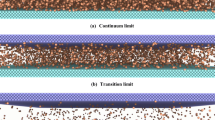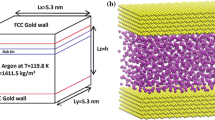Abstract.
The micro Poiseuille flow for liquid argon flowing in a nanoscale channel formed by two solid walls was studied in the present paper. The solid wall material was selected as platinum, which has well established interaction potential. We consider the intermolecular force not only among the liquid argon molecules, but also between the liquid argon atoms and the solid wall particles, therefore three regions, i.e. the liquid argon computation domain, the top and bottom solid wall regions are included for the force interaction. The present MD (Molecular Dynamics) simulation was performed without any assumptions at the wall surface. The objective of the study is to find how the flow and the slip boundaries at the wall surface are affected by the applied gravity force, or the shear rate. The MD simulations are performed in a nondimensional unit system, with the periodic boundary conditions applied except in the channel height direction. Once the steady state is reached, the macroscopic parameters are evaluated using the statistical mechanics approach. For all the cases tested numerically in the present paper, slip boundaries occur, and such slip velocity at the stationary wall surface increases with increasing the applied gravity force, or the shear rate. The slip length, which is defined as the distance that the liquid particles shall travel beyond the wall surfaces to reach the same velocity as the wall surface, sharply decreases at small shear rate, then slightly decreases with increasing the applied shear rate. We observe that the liquid viscosity remains nearly constant at small shear rates, and the Newtonian flow occurs. However, with increasing the shear rate, the viscosity increases and the non-Newtonian flow appears.










Similar content being viewed by others
References
Mohamed Gad-el-Hak (1999) The fluid mechanics of microdevices – the freeman scholar lecture. ASME J Fluids Eng 121(5): 5–33
Rostami AA; Mujumdar AS, Saniei AS (2002) Flow and heat transfer for gas flowing in microchannels: a review. Heat Mass Transfer 38: 359–367
Israelachvili JN (1986) Measurement of the viscosity of liquids in very thin films. J Colloid Interface Sci 110(1): 263–271
Gee ML; McGuiggan PM; Israelachvili JN; Homola AM (1990) Liquid to solidlike transitions of molecularly thin films under shear. J Chem Phys 93(3): 1895–1906
Chan DYC; Horn RG (1985) Drainage of thin liquid films. J Chem Phys 83(10): 5311–5324
Debye P; Cleland RL (1959) Flow of liquid hydrocarbons in porous vycor. J Appl Phys 30(6): 843–849
Maynes D; Webb AR (2002) Velocity profile characterization in sub-millimeter diameter tubes using molecular tagging velocimetry. Exp Fluids 32: 3–15
Kopiik J; Banavar JR, Wiiiemsen JF (1989) Molecular dynamics of fluid at solid surfaces. Phys Fluids A 1(5): 781–794
Liem SY; Brown D; Clarke JHR (1992) Investigation of the homogeneous-shear nonequilibrium-molecular-dynamics method. Phys Rev A 45(6): 3706–3713
Thompson PA; Robbins MO (1990) Shear flow near solids: Epitaxial order and flow boundary conditions. Phys Rev A 41(12): 6830–6837
Thompson PA; Troian SM (1997) A general boundary condition for liquid flow at solid surfaces. Lett Nat 389(25): 360–362
Yi P; Poulikakos D; Walther J; Yadigaroglu G (2002) Molecular dynamics simulation of vaporization of an ultra-thin liquid argon layer on a surface. Int J Heat Mass Transfer 45: 2087–2100
Haile JM (1992) Molecular dynamics simulation, Interscience, New York
Alexander FJ; Garcia AL (1997) The direct simulation monte-carlo method. Comput Simulations 11(6): 588–593
Tenenbaum A; Ciccotti G; Gallico R (1982) Stationary nonequilibrium states by molecular dynamics – Fourier’s law. Phys Rev A 25(5): 2778–2787
Acknowledgements.
The authors would like to thank for the financial support by the National Natural Science Foundation of China with the contract number of 10272102.
Author information
Authors and Affiliations
Corresponding author
Rights and permissions
About this article
Cite this article
Xu, J.L., Zhou, Z.Q. Molecular dynamics simulation of liquid argon flow at platinum surfaces. Heat Mass Transfer 40, 859–869 (2004). https://doi.org/10.1007/s00231-003-0483-3
Received:
Published:
Issue Date:
DOI: https://doi.org/10.1007/s00231-003-0483-3




